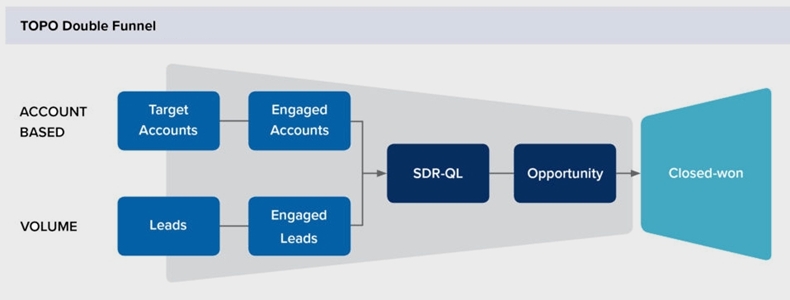Some of our biggest mistakes can teach us some of our greatest lessons. That's as true in business as it is in life.
Having worked with hundreds of customers and spoken with thousands of salespeople and marketers, my colleagues and I have seen just about every account-based marketing mistake that can be made.
In this article, I share some of the most common and costly mistakes marketers make when implementing and executing ABM. I will also share how you can avoid making those mistakes.
Mistake #1: Thinking That Having ABM Technology Means You're Doing ABM
Too often, we see companies purchase an ABM technology and think they're doing ABM simply because they have the technology. Often, they make the purchase because someone high up barked, "Go do ABM!"
ABM is a strategy. Tools and technology simply help you execute it.
First, determine whether ABM is the right go-to-market strategy for your business. Next, define what ABM means for your organization. Only then look at the technology. Doing it any other way would be putting the cart before the horse.
Moreover, not all ABM technology is created equal. There's a lot of ABM tech out there, and it can get confusing. This article includes ideas on where you should invest first.
Mistake #2: Running ABM Ads and Thinking That Means You're Doing ABM
Running ads can be, and often is, part of your overall ABM strategy; but, alone, ads don't constitute a strategy.
If you're following the three-tiered approach to ABM, like many organizations are, then ABM ads would be a good tier-three tactic to maintain "air cover" on your target accounts.
Here the goal is to increase awareness to a broader set of people. The reason ads are appealing is that they allow you to scale your ABM efforts. At the end of the day, ads remain a programmatic way of delivering a message to many people at once. And, as we all know, ads are not perfect (think bots, ad blockers, and viewer fatigue).
Don't get me wrong: I'm not saying don't do ABM ads. I'm saying that if you're doing ABM ads, it must be one piece of an orchestrated campaign.
Mistake #3: Using ABM Only for Acquiring New Logos and Not Selling to Your Existing Customers
"Acquiring a new customer is anywhere from five to 25 times more expensive than retaining an existing one." (HBR, 2014.)
If you look at some true enterprise companies, most of their revenue actually comes from existing customers. A lot of us come from traditional demand generation, and we're used to going after new logos and acquiring those new names. But that's not the single focus anymore; we must pay attention to post-sale opportunities as well.
Just as you have a playbook for acquiring new business, create a playbook for expansion opportunities to sell to existing customers.
Mistake #4: Replacing Demand Generation With ABM
It's no secret that ABM delivers results. Year after year, study after study, companies prove that ABM delivers better ROI than any other strategy. It's only natural to jump in on the action and start doing ABM, too.
However, trouble comes when you abandon your demand gen strategies altogether for ABM.
It's not an either/or choice. In fact, you should be doing both ABM and demand gen. If your company is one of the few out there that sell only to the Fortune 100, then you're the exception. If that's you, chances are you're already doing ABM. Otherwise, the rest of us benefit greatly by having targeted marketing strategies to go after named accounts as well as broad inbound marketing strategies to provide broad air cover.
The real question should be, What's your mix? In other words: How much ABM and how much demand gen should you be doing?
It's best to think of it as a spectrum: Generally, the larger and more complex your deals, the more your go-to-market strategy will rely on ABM; at the other end of the spectrum, the smaller your deals, the more you need high-velocity deals, and, thus, your go-to-market strategy will rely more on demand generation tactics.
Mistake #5: Getting Rid of MQLs and Replacing Them With MQAs
Over the past decade, marketers have been trained to chase the Marketing-qualified leads (MQLs) as if their lives depended on it. However, with the focus on accounts, many analysts, influencers, and thought leaders have been putting a new metric on the proverbial pedestal: Marketing-qualified accounts (MQAs).
Now, as if following the lure of the siren's song, Odysseus and his fleet of marketers have abandoned MQLs to pursue MQAs.
All marketers worth their salt know they must track their performance. However, a problem arises when marketers stop paying attention to MQLs and move to tracking only MQAs. As I noted earlier, you need both ABM and demand gen; therefore, you must measure both MQLs and MQAs.
Keep that lead funnel you've already spent countless hours building and lost more sleep over than you care to admit. The trick is adding on the account funnel.
I know, easier said than done. I love the approach that TOPO takes with its "double funnel." This approach allows you to maximize both strategies by implementing ABM while managing inbound accounts that are expressing intent but aren't necessarily on your named account list.

Source: TOPO, 2019
Mistake #6: Lack of Alignment Between Sales and Marketing
Fundamentally, Marketing exists to support Sales. And Sales can't execute without help from Marketing. Your entire ABM strategy hinges on not just alignment but also coordination and action.
Account-based marketing is a bit of a misnomer. Though "marketing" is in the name, its success relies on Sales, Marketing, and everyone else in the company. If you want to close bigger deals, if you have more complex sales cycles, if you really are looking to go upmarket, everyone must be involved. It's your Sales, your SDR, BDR team. It's your Customer Success, account managers.
Everyone must be aligned, looking at the same account-level data, and coordinating interactions together to close larger deals.
Mistake #7: Thinking That Getting Started With ABM Takes a Lot of Work
Sure, ABM can seem daunting. With all the new technology and tactics and processes, it's a lot!
It's true catching up to mature organizations that have been doing ABM for years can seem a herculean task, but that doesn't mean you can't start small and get quick, easy wins right now.
Start by taking your top campaign, segment your audience, refine your message to speak more directly to them, determine your most effective channel to deliver that message, and voila! You're doing ABM. No additional tools are necessary.
After you see some success, begin to build on it. Do so asynchronously—while you're putting some of the larger foundational ABM pieces into place, such as selecting your target accounts, implementing orchestration software, or managing the change in your organization.
* * *
Along your ABM journey, you may encounter defeat, but you must not be defeated. Hopefully, this article provided some insight into how you can avoid the costliest ABM mistakes.
But if you do face challenges, don't let them stop you from ultimately succeeding with ABM. You can overcome them.




